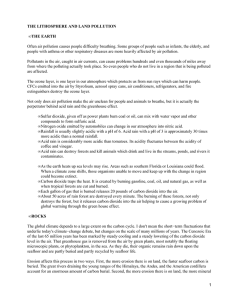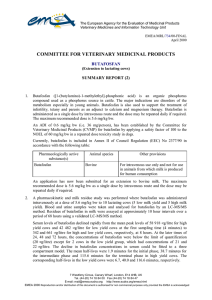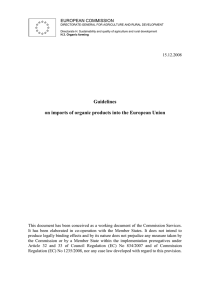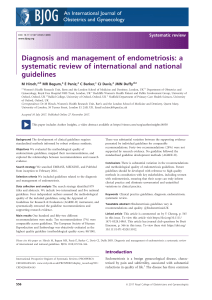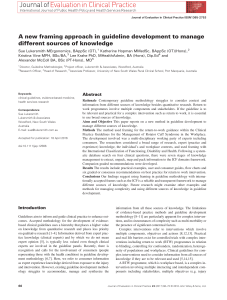12.37 DDT and metabolites - World Health Organization
Anuncio
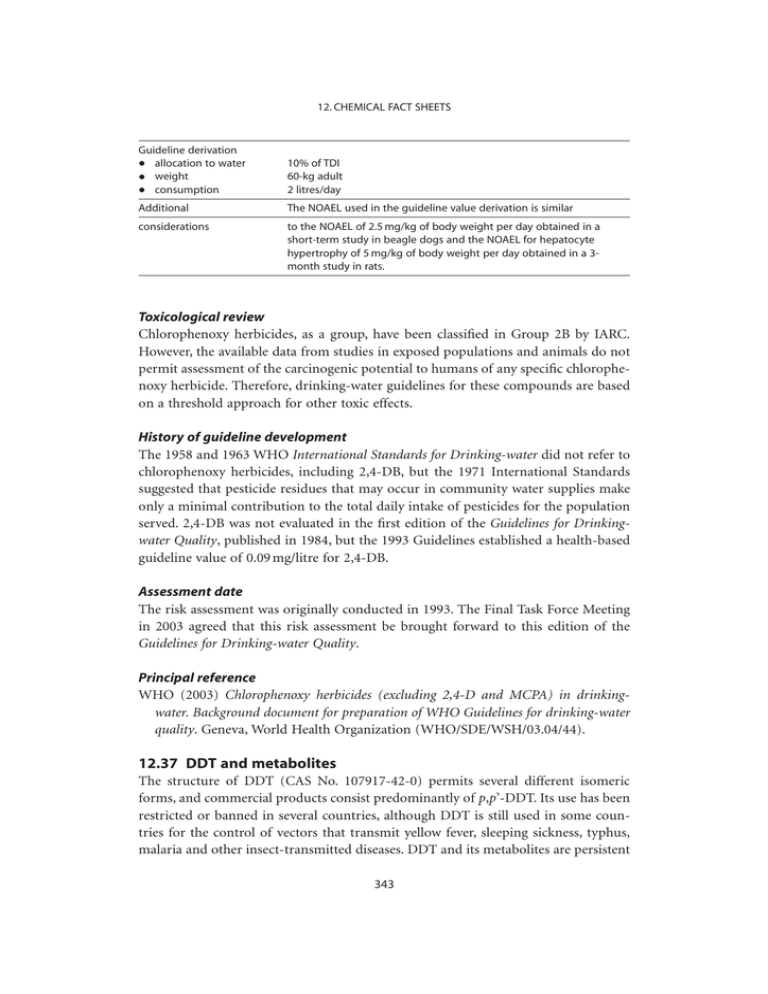
12. CHEMICAL FACT SHEETS Guideline derivation allocation to water weight consumption • • • 10% of TDI 60-kg adult 2 litres/day Additional The NOAEL used in the guideline value derivation is similar considerations to the NOAEL of 2.5 mg/kg of body weight per day obtained in a short-term study in beagle dogs and the NOAEL for hepatocyte hypertrophy of 5 mg/kg of body weight per day obtained in a 3month study in rats. Toxicological review Chlorophenoxy herbicides, as a group, have been classified in Group 2B by IARC. However, the available data from studies in exposed populations and animals do not permit assessment of the carcinogenic potential to humans of any specific chlorophenoxy herbicide. Therefore, drinking-water guidelines for these compounds are based on a threshold approach for other toxic effects. History of guideline development The 1958 and 1963 WHO International Standards for Drinking-water did not refer to chlorophenoxy herbicides, including 2,4-DB, but the 1971 International Standards suggested that pesticide residues that may occur in community water supplies make only a minimal contribution to the total daily intake of pesticides for the population served. 2,4-DB was not evaluated in the first edition of the Guidelines for Drinkingwater Quality, published in 1984, but the 1993 Guidelines established a health-based guideline value of 0.09 mg/litre for 2,4-DB. Assessment date The risk assessment was originally conducted in 1993. The Final Task Force Meeting in 2003 agreed that this risk assessment be brought forward to this edition of the Guidelines for Drinking-water Quality. Principal reference WHO (2003) Chlorophenoxy herbicides (excluding 2,4-D and MCPA) in drinkingwater. Background document for preparation of WHO Guidelines for drinking-water quality. Geneva, World Health Organization (WHO/SDE/WSH/03.04/44). 12.37 DDT and metabolites The structure of DDT (CAS No. 107917-42-0) permits several different isomeric forms, and commercial products consist predominantly of p,p’-DDT. Its use has been restricted or banned in several countries, although DDT is still used in some countries for the control of vectors that transmit yellow fever, sleeping sickness, typhus, malaria and other insect-transmitted diseases. DDT and its metabolites are persistent 343 GUIDELINES FOR DRINKING-WATER QUALITY in the environment and resistant to complete degradation by microorganisms. Food is the major source of intake of DDT and related compounds for the general population. Guideline value 0.001 mg/litre Occurrence Detected in surface water at concentrations below 1 mg/litre; also detected in drinking-water at 100-fold lower concentrations PTDI 0.01 mg/kg of body weight based on a NOAEL of 1 mg/kg of body weight per day for developmental toxicity in rats, applying an uncertainty factor of 100 Limit of detection 0.011 mg/litre by GC using an ECD Treatment achievability 0.1 mg/litre should be achievable using coagulation or GAC Guideline derivation allocation to water weight consumption 1% of PTDI 10-kg child 1 litre/day • • • Additional comments • • • DDT is listed under the Stockholm Convention on Persistent Organic Pollutants. Hence, monitoring may occur in addition to that required by drinking-water guidelines. The guideline value is derived on the basis of a 10-kg child consuming 1 litre of drinking-water per day, because infants and children may be exposed to greater amounts of chemicals in relation to their body weight and because of concern over the bioaccumulation of DDT. It should be emphasized that the benefits of DDT use in malaria and other vector control programmes outweigh any health risk from the presence of DDT in drinking-water. Toxicological review A working group convened by IARC classified the DDT complex as a non-genotoxic carcinogen in rodents and a potent promoter of liver tumours. IARC has concluded that there is insufficient evidence in humans and sufficient evidence in experimental animals for the carcinogenicity of DDT (Group 2B) based upon liver tumours observed in rats and mice. The results of epidemiological studies of pancreatic cancer, multiple myeloma, non-Hodgkin lymphoma and uterine cancer did not support the hypothesis of an association with environmental exposure to the DDT complex. Conflicting data were obtained with regard to some genotoxic end-points. In most studies, DDT did not induce genotoxic effects in rodent or human cell systems, nor was it mutagenic to fungi or bacteria. The US Agency for Toxic Substances and Disease Registry concluded that the DDT complex could impair reproduction and/or development in several species. Hepatic effects of DDT in rats include increased liver weights, hypertrophy, hyperplasia, induction of microsomal enzymes, including cytochrome P450, cell necrosis, increased activity of serum liver enzymes and mitogenic effects, which might be related to a regenerative liver response to DDT. 344 12. CHEMICAL FACT SHEETS History of guideline development The 1958 and 1963 WHO International Standards for Drinking-water did not refer to DDT, but the 1971 International Standards suggested that pesticide residues that may occur in community water supplies make only a minimal contribution to the total daily intake of pesticides for the population served. In the first edition of the Guidelines for Drinking-water Quality, published in 1984, a health-based guideline value of 0.001 mg/litre was recommended for DDT (total isomers), based on the ADI recommended by JMPR in 1969. The 1993 Guidelines established a health-based guideline value of 0.002 mg/litre for DDT and its metabolites in drinking-water, derived from the ADI recommended by JMPR in 1984 and taking into consideration the fact that infants and children may be exposed to greater amounts of chemicals in relation to their body weight, concern over the bioaccumulation of DDT and the significant exposure to DDT by routes other than water. It was noted that the guideline value exceeds the water solubility of DDT of 0.001 mg/litre, but that some DDT may be adsorbed onto the small amount of particulate matter present in drinking-water, so the guideline value could be reached under certain circumstances. It was also emphasized that the benefits of DDT use in malaria and other vector control programmes far outweigh any health risk from the presence of DDT in drinking-water. Assessment date The risk assessment was conducted in 2003. Principal references FAO/WHO (2001) Pesticide residues in food – 2000. Evaluations – 2000. Part II – Toxicology. Geneva, World Health Organization, Joint FAO/WHO Meeting on Pesticide Residues (WHO/PCS/01.3). WHO (2003) DDT and its derivatives in drinking-water. Background document for preparation of WHO Guidelines for drinking-water quality. Geneva, World Health Organization (WHO/SDE/WSH/03.04/89). 12.38 Dialkyltins The group of chemicals known as the organotins is composed of a large number of compounds with differing properties and applications. The most widely used of the organotins are the disubstituted compounds, which are employed as stabilizers in plastics, including polyvinyl chloride (PVC) water pipes, and the trisubstituted compounds, which are widely used as biocides. The disubstituted compounds that may leach from PVC water pipes at low concentrations for a short time after installation are primarily immunotoxins, although they appear to be of low general toxicity. The data available are insufficient to permit the proposal of guideline values for individual dialkyltins. 345
